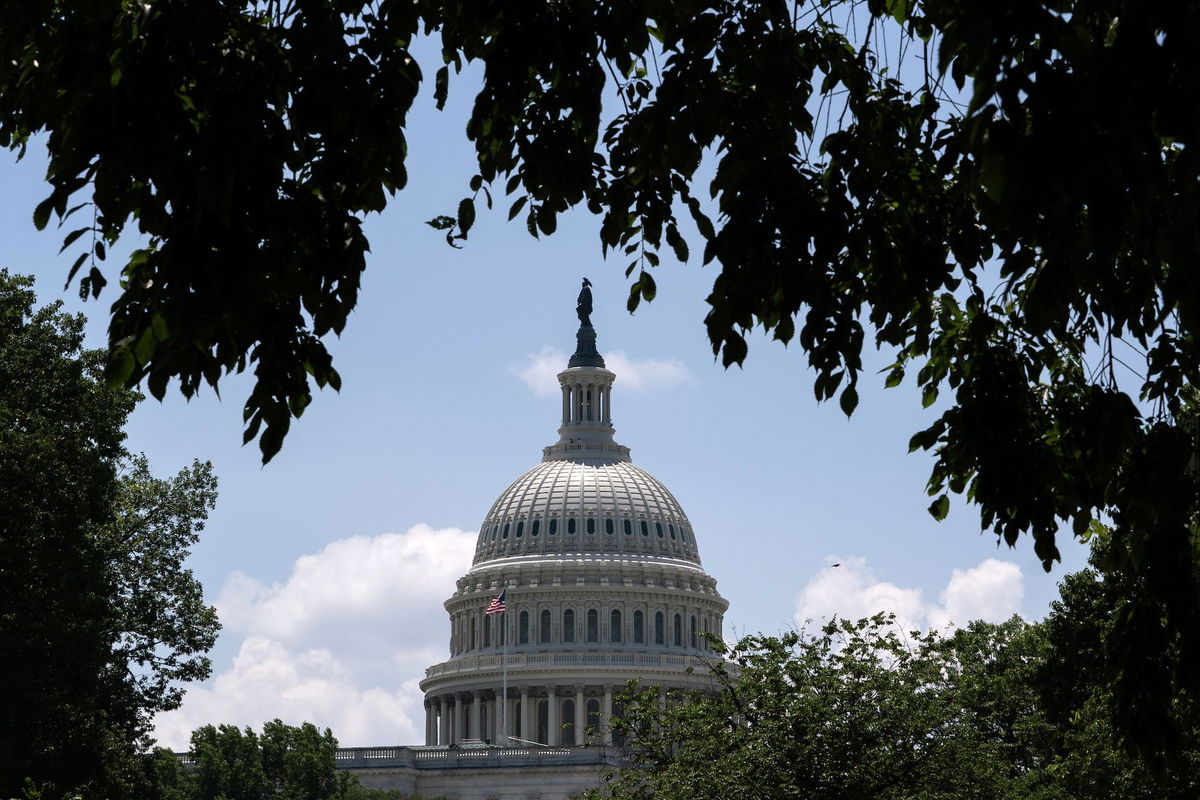Student loan relief contributing to 27% jump in projected federal budget deficit, per CBO

By Tami Luhby, CNN
(CNN) — The federal budget deficit will hit $1.9 trillion this fiscal year, according to an updated projection released Tuesday by the Congressional Budget Office. That’s 27% – or $400 billion – larger than the agency estimated in February.
Looking longer term, the nation’s debt will approach $57 trillion in fiscal year 2034, nearly $2.5 trillion higher than previously projected, as spending on Social Security, Medicare and interest payments soar and revenues fail to keep pace. The growing imbalance is expected to loom large over upcoming congressional budget and tax battles.
Most of the spike in the fiscal 2024 deficit stems from four factors that are expected to boost projected spending. The largest is a $145 billion increase that’s partly due to changes the Biden administration made to student loan repayment plans and a new, proposed forgiveness program that would waive some accrued interest for millions of borrowers. The latter has yet to be finalized but could take effect as soon as this fall.
Also, the CBO increased the projected outlays for deposit insurance by about $70 billion because the Federal Deposit Insurance Corporation is not recovering disbursements it made when resolving five bank failures from the last fiscal year and this fiscal year as quickly as anticipated. Three of the five bank failures in 2023 were among the largest bank failures in US history. To replenish the multibillion-dollar hit to the FDIC’s Deposit Insurance Fund due to recent bank failures, the agency is temporarily levying higher fees on hundreds of insured banks and selling off failed banks’ assets.
Newly enacted legislation is increasing projected discretionary spending by $60 billion, and estimated spending on Medicaid is about $50 billion higher because actual outlays so far in fiscal year 2024 have been larger than expected. The fiscal year began on October 1.
The cumulative deficit over the 2025 to 2034 period is now projected to be 10% – or $2.1 trillion – larger, the CBO said.
The nation’s ballooning budget deficits remain in the spotlight in this year’s presidential election, as presumptive nominees President Joe Biden and former President Donald Trump both promise to improve the nation’s fiscal status – but in very different ways.
Also, the imbalance between federal spending and tax revenue will factor heavily into Congress’ coming discussions on the fiscal year 2025 budget, the return of the debt ceiling in January, and the expiration of many provisions of the 2017 Tax Cuts and Jobs Act at the end of next year.
More than $3.4 trillion in individual income and estate tax cuts are set to expire at the end of 2025. Add in some corporate tax changes and interest, and the impact on the deficit swells to $4.6 trillion, according to a separate CBO analysis.
Though continuing the tax cuts will increase the deficit, Congress is not expected to allow all of them to expire. Trump and Republican lawmakers have said they want to extend them all, while Biden and Democratic lawmakers are calling for raising taxes on corporations and those earning more than $400,000 a year.
After adjusting to exclude timing shifts of certain payments, the CBO projects the deficit will be $2 trillion in fiscal year 2024 and grow to $2.8 trillion by fiscal year 2034.
In relation to economic output, federal debt held by the public will rise from 99% this fiscal year to 122% in fiscal year 2034, surpassing its historical peak, the agency said.
“CBO’s new report shows that the outlook for America’s critical national debt challenge is worsening,” Michael Peterson, CEO of the Peter G. Peterson Foundation, said in a statement. “This is an important time for a national conversation on these critical fiscal and economic challenges that we must address next year, and beyond.”
Immigration helps lower the deficit
One bright spot in the CBO report is that the recent surge in immigration is expected to lower deficits by a net total of $0.9 trillion over the 2024 to 2034 period.
The agency looked at an immigration category that includes people who entered the US illegally and have not obtained permanent legal status, people who entered lawfully through the use of parole authority and who may be awaiting proceedings in an immigration court and people who had temporary legal status but remained in the country after it expired.
The CBO estimates that net immigration of people in this category will total 2.4 million in 2024 and decline in subsequent years. Between 2021 and 2026, the agency projects the number of these immigrants will be 8.7 million greater than it would have been had net immigration remained at its expected level. However, it warns that these projections are subject to “much uncertainty.”
The surge is expected to boost revenues by about $1.2 trillion over the coming decade, mostly because the immigrants will pay income and payroll taxes on their earnings, the agency projects. It estimates that about half the immigrants in the surge will be authorized for work and notes that people without work permits will pay some taxes, though they are less likely to do so.
Plus, the increase in immigration will lead to more economic activity, which will broadly boost income and tax revenues, the agency forecasts.
Uninsured rate expected to rise
The nation’s uninsured rate hit an all-time low of 7.2% last year, but that figure is expected to rise to 8.9% in 2034, under a separate CBO analysis released Tuesday. The increase is mainly due to the end of a Covid-19 pandemic provision that barred states from disenrolling Medicaid enrollees until 2023, the expiration of enhanced Affordable Care Act premium subsidies at the end of 2025 and the surge in the number of immigrants, who are much more likely to be uninsured.
The largest increase in the uninsured will be among adults ages 19 to 44, the agency estimates. Medicare enrollment is expected to swell from 61 million this year to 74 million in 2034, as the population ages. The number of people with Medicaid coverage is projected to drop from 92 million last year to about 79 million in coming years as a result of the end of the pandemic-era protection.
Affordable Care Act enrollment is forecast to hit an all-time high of 23 million people next year and then fall to 16 million in 2034. Permanently extending the subsidies beyond 2025 would increase individual market coverage (both on and off the Obamacare exchanges) by 7.1 million, according to a third CBO report.
The CBO’s health insurance coverage projections will not be welcome news for the Biden campaign. The president has repeatedly touted the expansion of health insurance coverage during his administration. Congressional Democrats are hoping to extend the enhanced subsidies as part of negotiations over extending the 2017 tax cuts.
This story has been updated with additional information.
CNN’s Katie Lobosco and Elisabeth Buchwald contributed to this report.
The-CNN-Wire
™ & © 2024 Cable News Network, Inc., a Warner Bros. Discovery Company. All rights reserved.

